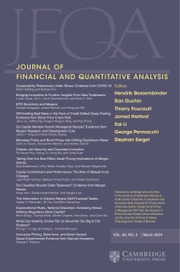No CrossRef data available.
Article contents
Competition and Debt Conservatism
Published online by Cambridge University Press: 05 November 2025
Abstract
Exploiting changes in countries’ competition laws, we find that competition increases firms’ propensity to use zero leverage (ZL). We test the financial-flexibility, financial-constraint, and quiet-life explanations for this result, concluding that desire for flexibility is the one most likely. The relation between competition and ZL strengthens with cash-flow volatility, which supports the flexibility motive. Adoption of ZL by firms is accompanied by increases in payouts, so it is unlikely that ZL adopters are constrained. Proxies for governance have no effect on the relation between competition and ZL, suggesting that desire for a quiet life is not the explanation either.
Information
- Type
- Research Article
- Information
- Creative Commons
- This is an Open Access article, distributed under the terms of the Creative Commons Attribution licence (http://creativecommons.org/licenses/by/4.0), which permits unrestricted re-use, distribution and reproduction, provided the original article is properly cited.
- Copyright
- © The Author(s), 2025. Published by Cambridge University Press on behalf of the Michael G. Foster School of Business, University of Washington
Footnotes
We are grateful to Jarrad Harford (the editor), an anonymous reviewer, Simone Lenzu (discussant), Amanjot Singh (discussant), Rakesh Jory, Ross Levine, Bo Wang, Jason Zhang, and participants at the 2025 European Financial Management Association Conference, the 2025 Financial Management Association European Conference, and a seminar at Southampton Business School. All errors are our own.

